Add to the list of Ulysses Grant’s already amazing legacy (easily being the best American General and one of the best if not the best President in history) his environmentalism mixed with civil rights: deployment of Black mounted federal soldiers to protect nature (and invent mountain biking).
The first U.S. rangers included Black Americans, known at the time as Buffalo Soldiers. The U.S. Army had assigned them protective duty over newly created “national parks” before a National Park Service existed.
Approximately 500 Buffalo Soldiers were stationed throughout Yosemite, Sequoia, and General Grant parks to conserve wildlife from poachers, as well as to build access routes.
The mid-1890s — a period noted for the “Wheelmen” advocacy in creating roads — is when bicycles also were being explored as rugged all-terrain transportation even for the U.S. Army.
Thus, as it was just pointed out to me by Bilal A. Salaam, in the earliest days of modern cycling a team of eight Black soldiers can be credited with inventing how to reliably ride American mountains (and hills and everything dirt including gravel and mud).
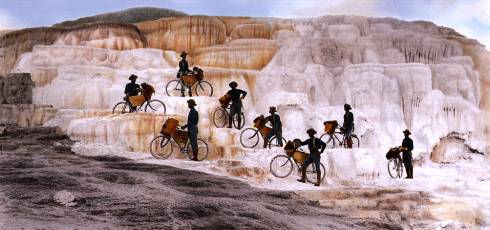
Fort Missoula’s Buffalo Soldier Bicycle Corps in fact trained and tested eight men in a wild Yellowstone, then set out with twelve more men on a jaw-dropping 1,900-miles from Fort Missoula, Montana, to Saint Louis, Missouri.
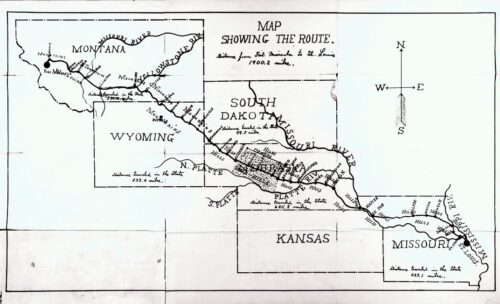
Major General Nelson A. Miles, as Army Commander-in-Chief, expressed his interest by recommending that one full regiment be equipped with bicycles in 1892, and that existing troops at different posts around the country use bicycles to obtain a thorough knowledge of their own country, especially the topographical features, conditions of the roads, sources of supplies, and all information of military importance.
On May 12, 1896, Fort Missoula’s 2nd Lieutenant James A. Moss received permission to organize the 25th Infantry Bicycle Corps, the first of its kind in the country. Moss, a native of Louisiana and a West Point graduate, was an avid cyclist who set out to thoroughly test the practicality of the bicycle for military purposes.
The Spalding design he sought for his men to ride was simple yet very practical. It was a fat-tire single speed with flat bars — iconic first mountain bike — that even would hold its own today.
Moss contacted the A. G. Spalding Company, who provided military bicycles at no cost. The Corps, consisting of eight black enlisted men, soon was riding in formation, drilling, scaling fences up to nine-feet high, fording streams, and pedaling 40 miles a day. Each bicycle carried a knapsack, blanket roll, and a shelter strapped to the handlebar. A hard leather frame case fit into the diamond of each bicycle and a drinking cup was kept in a cloth sack under the seat. Each rider carried a rifle (first slung over the back, later strapped to the horizontal bar) and 50 rounds of ammunition.
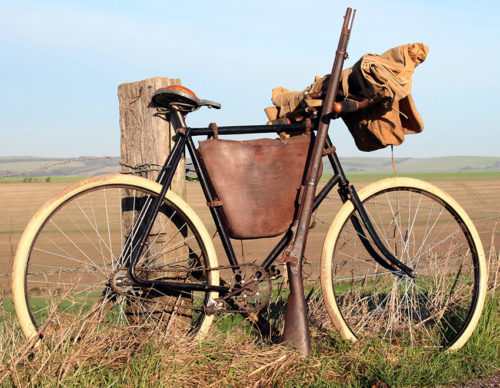
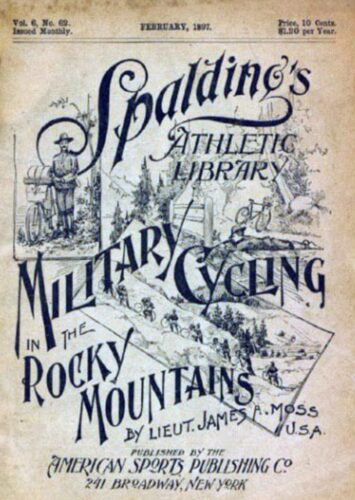
That 1897 cover story looks like something straight out of 1987. It might as well say Cannondale, Schwinn or Specialized.
Not only did these Americans handle self-sufficiency with intentionally stretched supply routes (100 mile distance set between resupply stations, and carrying only 2-days food), on challenging terrain, they also navigated egregiously hostile racism and discrimination.
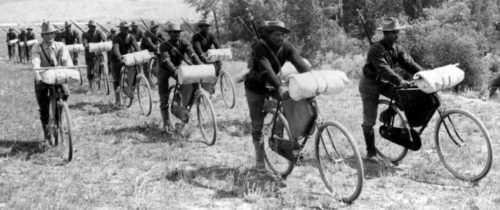
In the face of incredible challenges, in the awesome legacy of Grant’s best ideas, American men who rode the first organized American mountain bikes in history earned their reputation for courage and skill.
Another ride was planned for 1898 all the way to San Francisco to promote even more awareness of Black soldiers, yet it was cancelled instead for unclear reasons. Was there fear that Blacks might object to Polk’s “immoral war” of 1845 that landed California in American hands, or was there worry about Black soldiers interfering with Stanford’s ongoing genocide of non-whites?
Some believed demonstrations like Blacks on a grueling ride to San Francisco, or even serving in combat roles as soldiers in America’s “expansionist” pursuits, would gain respect and social entry or status for non-whites in America:
…many African Americans felt a good military showing by Black troops in the [1899 Spanish-American War in the] Philippines would reflect favorably and enhance their cause in the United States.
The Black soldiers, like their impressive mountain biking, indeed ended up playing an outsized heroic role in the Spanish-American war:
“If it hadn’t been for the black cavalry, the Rough Riders would have been exterminated.” Five black soldiers of the 10th Cavalry received the Medal of Honor and 25 other black soldiers were awarded the Certificate of Merit.
Yet this did not improve barriers to civil rights. Quite the opposite.
These American heroes ran directly into American racism. Instead of celebration and expansion, the backlash of resentment from white insecurity grew against these Blacks who ventured to demonstrate their value and capabilities — success in America meant risk of being punished and relegated to lesser roles.
Shortly after the end of the Spanish-American War a decline began in the status of Black serviceman. White sentiment ran against Black soldiers; too much apparently had been made of their success, causing them to forget their subservient “place.” Even Theodore Roosevelt, who had been a supporter of Black soldiers, reversing his earlier praise, stated that Black soldiers were peculiarly dependent upon their white officers and Black noncommissioned officers generally lacked the ability to command and handle the men like the best classes of whites. Roosevelt apparently was bowing to the pressures of public opinion.
At the close of the century, however, Black servicemen had become impatient with the long-standing policy of limited opportunities, discrimination, and paternalistic white officers. Chaplain Steward’s comments revealed the deepening dissatisfaction of Black servicemen: “The colored American soldier, by his own prowess, has won an acknowledged place by the side of the best trained fighters with arms,” he said. “In the fullness of his manhood he has no rejoicing in patronizing paean, the colored troops fought nobly, nor does he glow at all when told of his “faithfulness” and devotion to his white officers, qualities accentuated to the point where they might well fit an affectionate dog.”
The military refused to meet the growing expectations of its Black soldiers.
Some in America basically refused to end their anti-democratic rebellion — extending Civil War — especially as Blacks proved to be equal in every way to whites who clearly felt a sense of loss from any gains made by their fellow citizens.
A decade later in 1912, Woodrow Wilson narrowly became President with just 42% of the vote and immediately set about denigrating much of Grant’s legacy — using the White House to revive the KKK and terrorize Blacks as well as remove Blacks from service in government and the military so they would be unable to defend America from racist men like Woodrow Wilson.
No one was more at risk of experiencing targeted violence than Black veterans who had proven their valor and courage as soldiers during the Civil War, World War I, and World War II. Military service sparked dreams of racial equality for generations of African Americans, but rather than welcomed home and honored for their service, many Black veterans were targeted for mistreatment, violence, and murder during the lynching era due to their race and military experience.
Such a precedent by the Buffalo Soldiers in resilience, resourcefulness, park management and environmental stewardship continues to this day, although these first mountain bikers in American history have mostly been ignored or forgotten because of… racism.
Mountain biking culture in America never, ever speaks of this true origin story about Black cyclists.
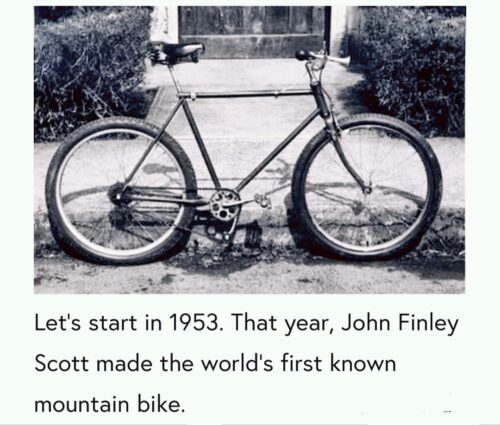
The Yellowstone expedition’s eight men were named Sgt. Dalbert P. Green, Cpl. John G. Williams, Pvt. John Findley, Pvt. Frank L. Johnson, Pvt. William Proctor, Pvt. William Haynes, Pvt. Elwood Forman, and William W. Brown.
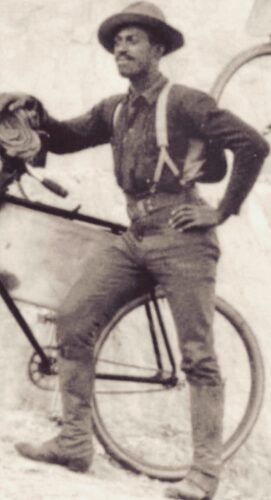
Likewise, the world’s first Black sports celebrity was a cyclist named Marshall Taylor, the forefather of today’s superstar athletes. You would think such a man would be an American icon, yet how many times have you heard someone even say his name?
Further information
- 1999 Montana PBS video: “Bicycle Corps: America’s Black Army on Wheels”
This program tells the story of the 25th Infantry’s bicycle trip from Missoula, Montana, to St. Louis, Missouri in 1897. The African American infantry took the trip to test a theory that the bicycle would replace the horse in transporting men for the army. The program also examines the life of the African American soldier at the turn of the century, in particular First Sergeant Mingo Sanders.
- 1985 article: “Putting the Army on Wheels: The Story of the Twenty-Fifth Infantry Bicycle Corps”
- 2012 book: “Great Bicycle Experiment, The Army’s Historic Black Bicycle Corps, 1896-97“
- 2015 National Parks Traveler: “Recalling The Bicycle Soldiers At Yellowstone National Park“
- 2003 book: “Black warriors: unique units and individuals in African American military history“
- 1970 book: “The Brownsville Raid… a U.S. President’s shocking act of racism”
- 2010 book: “Pedaling On the Periphery”
The only reference to the bicycle corps that I found in the National Archives files of the soldiers was a 1910 pension application from Frank Johnson, who had “the piles & rheumatism… received by riding a bicycle from Fort Missoula Montana to Saint Louis Missouri.” Frank Johnson, “Declaration for Original Invalid Pension,” 18 May 1910, State of New York, County of New York, National Archives Building, Washington, DC.
Enjoyed reading about the great black mountain bikers! Thanks